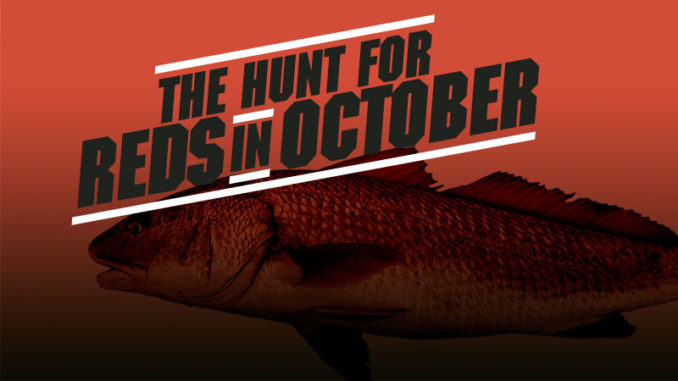
Surf and inlets south of Cape Lookout provide plenty of great fall action for beach-bound anglers.
If you ask saltwater anglers to choose the best month for fishing along North Carolina’s coast, half or more will pick October.
Fall weather changes the behavior of many saltwater fish, as cooling waters trigger an urge to leave the safety of creeks, marshes and sounds. Baitfish swim through coastal inlets and turn right when they hit the ocean, an annual procession that may begin in September but hits its peak during October.
And the baitfish parade isn’t alone.
Mullet, menhaden, herring, killifish, silversides and mud minnows provide summer food for gamefish, but fall’s first nor’easter, aka mullet blow, triggers an urge to swim south — except for mud minnows, which overwinter in the marsh.
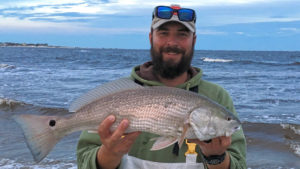
Red drum, speckled trout and flounder follow this moveable feast, which may last through November. Knowledgeable surf anglers know about fall concentrations of bait and gamefish.
One of the most-popular target species is red drum. Of course, effective baits or lures are important if an angler aims to battle reds. Luckily, they’re identical to those that worked during spring and summer, but an important key to fall success is knowing where to find concentrations of reds.
Along the Outer Banks, surf fishermen use long rods to heave cut bait as far as they can beyond distant, breaking waves. Fishing outside the breakers from a boat isn’t recommended because of rough water; from Cape Lookout north, the exposure of barrier islands to northeast winds makes sure footing in a small, bouncing boat a dicey proposition.
Surf fishing can be fabulous from those barrier islands: Bodie, Hatteras and Ocracoke, as well as the Core Banks. Every year, big red drum, sometimes 50-pound fish, are caught.
To the south, a choice exists.
Anglers who soak baits need the ability to read the surf and find productive sloughs, have decent equipment and know just where to cast their baits. This type of fishing often results in hours of scenery watching, broken by re-baiting hooks — and occasional catches of redfish.
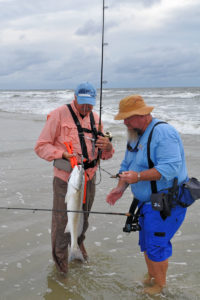
But if anglers want faster action and don’t mind walking, another technique is available.
Guide David Towler of Swansboro’s Towler Time Charters fishes for reds near the inlets that dot Onslow Bay — the area between Cape Lookout and Cape Fear — and he mostly uses artificial lures.
Towler (910-554-4742) will beach his boat on the mainland side of a barrier island, within walking distance of the surf, and he’ll cast until he finds red drum — sometimes big numbers of reds.
“When I was younger, I did a lot of drum fishing from a boat,” Towler said. “Now, I’d rather land the boat behind (an) island, walk to the ocean and fish the surf. It’s easy to cover a lot of water, and I don’t have to worry about (waves) tipping me or my passengers off balance in a boat.”
South of Cape Lookout’s shoals, beach contours recede to the southwest and don’t receive the brunt of waves driven by northeast winds. And the mainland and sand dunes block fall winds, except for an occasional tropical storm or hurricanes. That helps keep waves smaller, so it’s easier to fish the suds.
“We don’t catch as many big drum as they do at the Outer Banks, but every once in a while, somebody will land a big one,” Towler said.
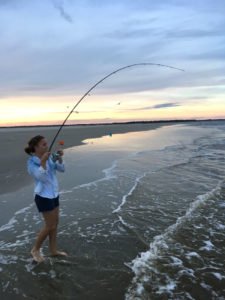
Larger, older redfish mostly prefer deeper water behind the breakers, farther out than Towler fishes, plus, they like live or cut baits. Towler would rather cast lures popular with fishermen who target largemouth or striped bass, so he doesn’t need a 12-foot rod, heavy bottom rig and sand spike. He fishes like a bass angler working the world’s largest pond, except that his line is a little stronger to accommodate the sizes of fish he chases.
“I use the same tackle I use fishing bays, creeks and marsh islands from a boat,” said Towler, whose equipment includes 7-foot, medium-action rods and 2500 Series spinning reels spooled with 15- to 20-pound braid tied to 2 feet of 25-pound fluorocarbon leader.
He uses three types of artificial lures: topwaters, spoons and soft-plastic lures that imitate minnows.
“I don’t wade out far because I don’t throw beyond the bars,” Towler said. “A lot of people throw over the fish. I think they’re copying the popular way to fish for drum like people do at Hatteras.
“I’ll walk into 2 or 3 feet of water where it’s calm. When you can see live mullets right under your feet, that’s where you want to fish.”
The best surf-fishing spots are at the northern corners of inlets, he said. Currents and waves scour out slightly deeper bottom features and provide resting and hiding places for baitfish as well as the crustaceans redfish like to eat. As a rule, the southern sides of inlets get filled in by sand migration, making them too shallow to attract gamefish.
When Towler casts soft-plastic lures around inlets, tidal currents move them down the beach. Slot (18 to 27 inches) and over-slot redfish prefer such spots at depths huge, old drum typically avoid.
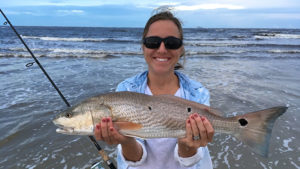
By walking and casting, anglers can find multiple reds. Once a person discovers a hot hole, the bite may continue for an hour — or longer. With medium-action rods, reds in the 3- to 15-pound range provide enjoyable action.
“I like to throw a 4- or 5-inch Z-Man paddletail or Z-Man Diesel MinnowZ,” Towler said. “They’re a little bigger than normal, soft-plastic lures, but they’ve got a bigger profile in the surf.”
When the surf is calm, his favorite hard-plastic lures include “a great big” Top Pup or big Zara Spook, walk-the-dog lures. When the surface is choppy, it’s difficult to work topwater lures properly, so Towler casts and retrieves a shiny, ½- to ¾-ounce gold Johnson spoon.
“If I’m using the Spook, I want a silver side and white belly,” he said. “Reds will crush a big topwater lure when conditions are right. But if it’s is too rough and topwaters don’t work as well, I’ll switch to a spoon or soft-plastic baits. If the water’s a little wavy and dingy, I’ll use soft-plastics,” Towler said.
When retrieved properly, topwater lures and flashy spoons resemble a large, wounded menhaden.
Air and water temperatures, especially from early to mid-October, usually are mild to warm, so anglers can wear shorts.
“You can get some cool snaps where light waders are comfortable, but I usually don’t start wearing waders until November,” he said.
 Onslow Bay has many red drum surf beaches
Onslow Bay has many red drum surf beaches
Although he usually sticks close to home when surf fishing for red drum, David Towler may visit several barrier-island beaches and inlets from Cape Lookout to the mouth of the Cape Fear River.
Towler’s favorite spots are southeast of his home in Hubert, N.C., and include Bogue Inlet, Bear Island, Bear Inlet and Browns Inlet — the latter when access isn’t restricted.
Browns Island’s shoreline isn’t fishable because the island is a Camp LeJeune target range, but anglers in boats can fish around the island and Browns Inlet — if the Marines aren’t holding target practice.
The first good Onslow Bay spot for surf fishing is Cape Lookout at the southern tip of Core Banks. Wind and currents sweep baitfish around its corner toward Barden Inlet and the Cape Lookout rock jetty, where redfish and spotted seatrout lie in wait each fall. Across Beaufort Inlet, the Fort Macon rock jetty also is a waypoint for baitfish and gamefish.
Bogue Inlet, 21½ miles southwest of Beaufort Inlet, is the next good fall redfish spot. Bear Island (the site of Hammocks Beach State Park) is the boundary on the southern side of Bogue Inlet. It’s a popular drum-fishing area, as is Bear Inlet at the island’s southern tip.
New River Inlet to the south also has excellent fishing for fall redfish.

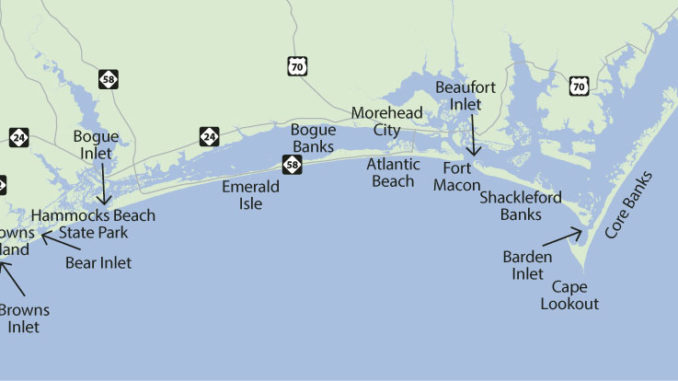

Be the first to comment